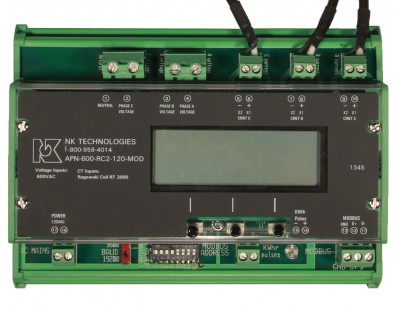
Installation of power monitoring can be a major headache. Since by definition the circuit voltage must be compared with the circuit current, the monitored circuit must be turned off before the installation can proceed. The voltage is then connected to the power monitor directly from a spare circuit breaker or through a fused potential transformer. Each phase current must also be measured and a signal corresponding to the amps used is passed to the power monitor. The most accurate inputs, both voltage and current, are ones with wave shapes nearly identical to the monitored circuit. This allows the power factor to be calculated.
Selecting a current transformer can be a challenge. The easiest approach is to select a split-core design, as they allow the existing wire or bus bar to be undisturbed. Placing a split-core CT over a wire or bus bar still requires some prior planning: The inside window must be large enough to allow the CT to be closed securely, and with bus assemblies, there must be enough room for the CT "legs" to fit between the bars. Standard 5 or 1 amps CT secondaries should be terminated onto a block with provision to short between the two leads. This extra effort allows the CT and main power to remain in an energized condition if there is a need to remove the power monitor. Leaving the CT secondary open can overheat the CT and create unsafe conditions as the potential between the secondary leads climbs to lethal levels.
NK Technologies' new APN Series takes a big step forward in power monitors from analog signal reporting watt consumption to a digital format that provides information on the system voltage, current, and power factor in addition to wattage. The RS485, Modbus RTU format is compatible with many programmable logic controllers and fits seamlessly into industrial communications networks, both hard wired and wireless depending on the specifics of the application.
New APN-R Power Monitor with Rogoswski Coil Inputs for Improved Accuracy
The APN-R design uses factory matched Rogowski coil inputs in two sizes. The flexible cable will conform to most any conductor shape, and can pass easily between bus bars. The Rogowski coil produces an output with very little wave shape distortion and at a very high degree of accuracy.
The primary circuit voltage is connected directly to the monitor for voltage of 600VAC or lower, or through a potential transformer for monitoring circuits of higher potentials. This new power monitor is powered from an external supply, improving measurement accuracy of the measurement data. The APN-R series also provides a pulse contact which opens and closes as watt hours are accumulated. This feature allows for a less complex data acquisition device for applications where the need to monitor circuit voltages or the other data points is minimal.
